BROADWAY THE HARD WAY: PARODIES AND CONVENTIONS
After the 1984 tour Zappa stopped touring each year, which he had by then done for twenty years. 1988 saw what would
become his last "Broadway the hard way" tour. In 1990 it was already a public secret that he had cancer, and when
its irrevocability had become clear, it was officially made public in 1991. The 1988 tour had a large band as
well as a large program. The new material with politically inspired lyrics appeared on the "Broadway the hard way" CD
from 1989. Most of the other "cover" material of his known compositions from the tour appeared on two 2 CD releases,
"The best band you've never heard before" and "Make a jazz noise here". To the right the five piece brass section of the 1988
band (still from the RTVE Barcelona live registration).
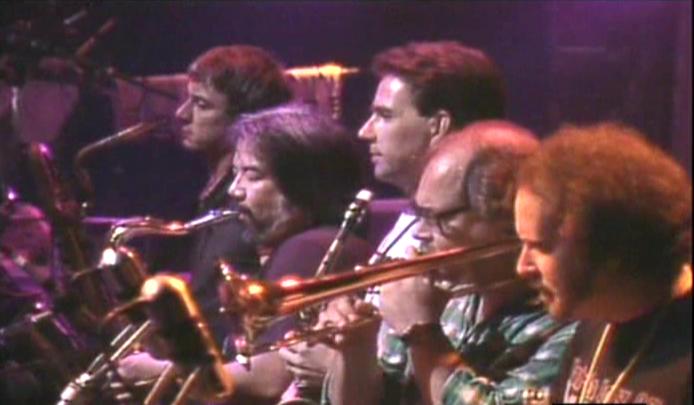 It's sometimes said that Zappa's music contains parodies.
It's difficult to say when something becomes a parody and when it's sincere. On "Cruising with Rubin and the Jets" the parody effect on doo-wop
lies in the outspoken simplicity of the songs and the use of higher voices as of young teenagers. Zappa calls these songs parodies
in "The real Frank Zappa book", but on the other hand, as he writes in the album liner notes, he really likes them.
The parody effect is stronger when certain clichés are used out of context, as the traditional waltz motif at the end of
the atonal composition "Pedro's dowry" on "Orchestral favorites" and "The London Symphony Orchestra". It sounds as a joke
at this place. This effect is also present after the orchestral "Tuna sandwich" block on "200 motels", when "Lonesome
cowboy Burt" starts with country and western cliché music. See the corresponding section for the opening bars.
The lyrics of "Lonesome cowboy Burt" confirm the parody intention:
they let Burt sing his about his unmannered and down to earth life. Zappa liked the brief use of clichés for their comic
effect. "Lumpy gravy" contains some of them, like the stereotype parallel fourths Chinese tune included in that section.
It's sometimes said that Zappa's music contains parodies.
It's difficult to say when something becomes a parody and when it's sincere. On "Cruising with Rubin and the Jets" the parody effect on doo-wop
lies in the outspoken simplicity of the songs and the use of higher voices as of young teenagers. Zappa calls these songs parodies
in "The real Frank Zappa book", but on the other hand, as he writes in the album liner notes, he really likes them.
The parody effect is stronger when certain clichés are used out of context, as the traditional waltz motif at the end of
the atonal composition "Pedro's dowry" on "Orchestral favorites" and "The London Symphony Orchestra". It sounds as a joke
at this place. This effect is also present after the orchestral "Tuna sandwich" block on "200 motels", when "Lonesome
cowboy Burt" starts with country and western cliché music. See the corresponding section for the opening bars.
The lyrics of "Lonesome cowboy Burt" confirm the parody intention:
they let Burt sing his about his unmannered and down to earth life. Zappa liked the brief use of clichés for their comic
effect. "Lumpy gravy" contains some of them, like the stereotype parallel fourths Chinese tune included in that section.
Welcome to the United States
"Welcome to the United States" from the 1993 CD with the Ensemble Modern features an intro with traditional
fanfare music. It sounds as a parody because of its context. The Ensemble Modern only plays modern music, also in case of Zappa,
so let them play some fanfare music sounds funny here. It's standard fanfare music in Eb, beginning with a bar in 6/4 and next continuing
in 4/4. The theme lasts eight bars. It gets repeated a couple of times in the backgroud, when the narrator starts to talk (bars 9-13, staff 1).
The intro in total lasts till 1:08. At this point the composed score starts. So the intro was added to this piece during rehearsals. The composed
part leaves a lot of space for improvisation. The text to be told by the narrator is set (Hermann in the case of the Ensemble Modern): it's
the literal text from the immigration form, you have to fill in when you enter the U.S. as a non-resident. Neither the pitches nor the rhythm are
prescribed. Only the outlines of the accompaniment are indicated. On the CD you hear how the ensemble worked out the sample of the score, that's
reproduced in the CD booklet. This sample coincides with 1:08-1:46 on the CD.
Welcome to the United States, 0:01-0:19 (midi file).
Welcome to the United States, 0:01-0:19 (transcription).
Welcome to the United States, 1:08-1:46 (score).

In the CD booklet you can read Zappa's own comment about the first example from above, shown here above. It's included in the page about
"Food gathering in post-industrial America". On the CD, however, this episode is part of the next track. A Tusch is a musical sign,
being no more than a major triad in a few positions. The one below is the Karneval variant. In Holland they chant "alaaf" along with it.
Even though I'm Dutch, I don't know what it means. Probably something like "hurray" in English or "arriba, andale" in Spanish.
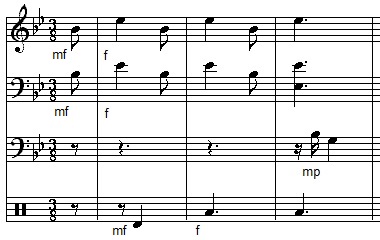
The Tusch from "Welcome to the United States", 0:30-0:35.
Many songs on "Broadway the hard way" have little parody effects in them. Like "the big old cadenza" in "Planet of the
baritone women"; the parade music that follows upon "Do you believe in the invisible army?" in "When the lie is so big";
the striptease music that introduces "What kind of girl?", etc.
1. Elvis has left the building
All newly composed titles for the 1988 tour with lyrics can be found on "Broadway the hard way". A few new instrumentals appeared on
the two double CDs from the next section, where I've included for instance the intro from "When yuppies go to hell". "Broadway the hard way"
begins with three pop-song you might call mainstream. During the opening song Zappa is making some fun of the unstoppable Elvis
worship in a mild manner. Other than in classical music, in pop music people generally fail to distinguish between performing music and composing music.
They sort of identify the person on stage with the music he or she is playing.
Elvis is a charming and impressive performer, but he didn't write rock 'n roll songs himself as Chuck Berry did.
Elvis has left the building, intro (midi file).
Elvis has left the building, intro (transcription).
The song begins with Zappa making the announcement that Elvis has left the building. It's a known line from concerts by Elvis to disencourage
female fans to stay in the building after the concert had finished, hoping to see him in the corridors. Zappa is using it in a figurative manner,
for Elvis leaving the building to ascend to heaven. It gets followed by the instrumental intro from above, featuring two times the progression
I-II-VII-II-I in D Mixolydian, also the progression from the main theme. During the second II-chord the bass C gets sustained, so it can also be
identified as VII 7th (Cmaj7). This intro can be heard between 0:10 and 0:25, returning slightly different between 1:28 and 1:44.
2. Planet of the baritone women
Regarding sound, the inclusion of the brass section gives many songs from the 1988 tour a special flavour. As I've been
commenting upon in the Them or us section, instrumentation paragraph, Zappa didn't like to include extra instruments just for doubling parts.
He wanted them to play lines and motifs of their own as well, and enrich the harmonies. This can be well heard during for instance
"Planet of the baritone women".
Planet of the baritone women, lyrics-chords samples.
On internet I could find thumbnails of the lyrics with chords published by Kobalt music. It's an authorized issue.
As you can see, the song is made up of three themes, with the instrumental intro using the chord progression from the opening
line of theme one.
Planet of the baritone women, 1:06-1:19 (midi file).
Planet of the baritone women, 1:06-1:19 (transcription).
The example from above is from the middle of this song, using the chords from verse three.
As I'm hearing it the D7(b9) chord is played a little different, namely as Dm7-5 the first time
(bar 1). The second time it's indeed D7(b9). Bars 4-5 from my example are part of what you
might call a little interlude with Bobby Martin continuing singing a "big old cadenza".
The meters vary. Bar 5 contains an Arab-like melismatic melody. At the beginning its notes are played
that fast that the transcription can only be an approximation. While G could be called the tonic,
notes are altering all the time. So it can't be assigned to a specific key.
The song gets introduced by Zappa saying "Meanwhile, on Broadway ..." What this song is about is kind of vague. Something happening there
is getting compared with a show ("planet of the baritone women"), possibly office scenes, with women trying to speak with low voices and some of the men carrying purses.
3. Any kind of pain
"Any kind of pain" however is about all conventional and
has no parody effects. It's the most commercial song on the CD, but still has some complexities as changing keys
and the adding in of two 7/8 bars. The song opens with a II 7th - I progression in F. In bar 15-16 it has arrived at
B flat minor. The 7/8 bars cause an acceleration effect, a little stretto they would say in classical music. The set-up of "Any kind of pain" is
the following verse - refrain construction, with a guitar solo functioning as the bridge:
Verse:
0:00 Instrumental intro (bars 1-4 in the transcription below, the key is F till bar 8).
0:08 Motif 1 (bars 5-8).
0:19 Motif 2 (bars 9-10, modulation to G).
0:23 Motif 3 (bars 11-14, C minor).
0:33 Motif 4 (bars 15-17, Bb minor).
Refrain:
0:40 Main theme, played twice (bars 18-25, F Lydian).
0:59 Variation upon the main theme (bars 26-30 (with the little stretto), first with a chord alternation of Am-Bb, in its tail ending in A minor).
Any kind of pain, opening (midi file).
Any kind of pain, opening (transcription).
Verse:
1:14 Instrumental intro.
1:23 Motif 1.
1:33 Motif 2.
1:38 Motif 3.
1:48 Motif 4.
Refrain:
1:55 Main theme, played twice.
2:13 Variation upon the main.
Bridge:
2:28 Guitar solo in F Lydian with the main chord progression I-VII. The bass is alternating F and E.
Verse:
4:18 Instrumental intro.
4:27 Motif 1.
4:37 Motif 2.
4:41 Motif 3.
4:51 Motif 4, repeated three times in the form of a sequence, moving up a major second each time (in total a diminished fifth).
Refrain:
5:11 Main theme, played twice (following the previous sequence, the main theme also gets transposed up a diminished fifth, thus
going from F Lydian to B Lydian).
5:30 Variation upon the main theme.
5:42 End.
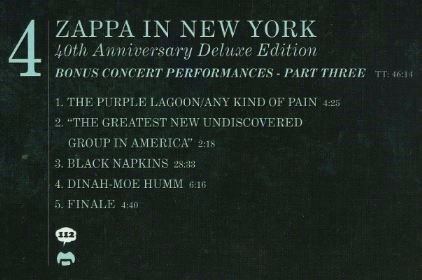
The 2019 ZFT 5-CD Deluxe edition of "Zappa in New York" shows that the chorus of "Any kind of pain"
already existed in 1976, serving as a second theme for "The purple lagoon". Above the tracklist of CD 4.
4. Dickie's such an asshole
From track 4 onwards we're getting at the political and anti-religious part of the CD. "Dickie's such an asshole" is a song Zappa had in stock since 1973 from the Watergate scandal era. It still fits in well in this context. The original recording from the Roxy theatre got included in "YCDTOSA Vol. III". Two examples from this latter version are included in the Roxy section of this study. See the next track for examples of allusions, that can be found in both titles 4 and 5.
5. When the lie's so big
"When the lie's so big" is another mainstream pop-song, summarizing Zappa's dislike of
tv-evangelists and their support of the Republican party.
When the lie's so big, 0:00-0:31 (midi file).
When the lie's so big, 0:00-0:31 (transcription).
The example above is its opening. During bars 1-4 the chord progression Em-F-G is played with Ike Willis speaking over it and Scott Thunes
improvising chromatic notes. In bar 5 the bass sets the key to G Mixolydian, so the progression becomes VI-VII-I, sort of a cadence.
Bar 8 is the type of interrupting bar Zappa loved to add to such songs, containing a repeated one-note figure with a triplet within a triplet.
In bar 9 the song has modulated to Ab Mixolydian.
When the lie's so big/Dickie's such an asshole, samples.
In 1995 Christopher J. Smith published an article, called "Broadway the hard way: techniques of allusion in the music of Frank Zappa".
One example of these allusions is citing from "The battle hymn of the Republic" (with two samples included above), about which Christopher writes:
"Zappa referred to certain stylistic, idiomatic, and timbral elements, and his manipulation of these elements for their
allusive impact as "Archetypal American musical icons" [quoting Zappa from The real Frank Zappa Book]:
"I attempt to devise "language" that will describe my musical intentions, in shorthand form . . . There's an
assortment of "stock modules" used in our stage arrangements . . . These "stock modules"
include the "Twilight Zone" Texture (which may not be the actual Twilight Zone notes, but the
same "texture"), the Mister Rogers texture, the "Jaws" texture . . . and things that sound
either exactly like or very similar to "Louie Louie." These are Archetypal American Musical Icons, and their
presence in an arrangement puts a spin on any lyric in their vicinity. When present, these modules "suggest" that
you interpret those lyrics within parentheses".
Use of "Archetypal American musical icons," then, connotes deliberate compositional incorporation of
musical quotation and allusion in order to influence reception. Such allusive material can consist
of or combine motivic, rhythmic, textural, timbral, textual or harmonic elements.
A specific archetypal American musical icon, "The Battle Hymn of the Republic" is quoted five times in four pieces, each time with consistent allusive intent:
- "Dickie's such an asshole", to refer to former Republican U.S. President Richard Nixon.
- "When the Lie's So Big," referring to Reagan-era Republican political leaders.
- "What Kind of Girl?," referring to television evangelist Pat Robertson's political affiliations.
- twice in "Jesus Thinks You're a Jerk," referring first to young members of the Republican party, and then to lynch-mob mentality."
6. Rhymin' man
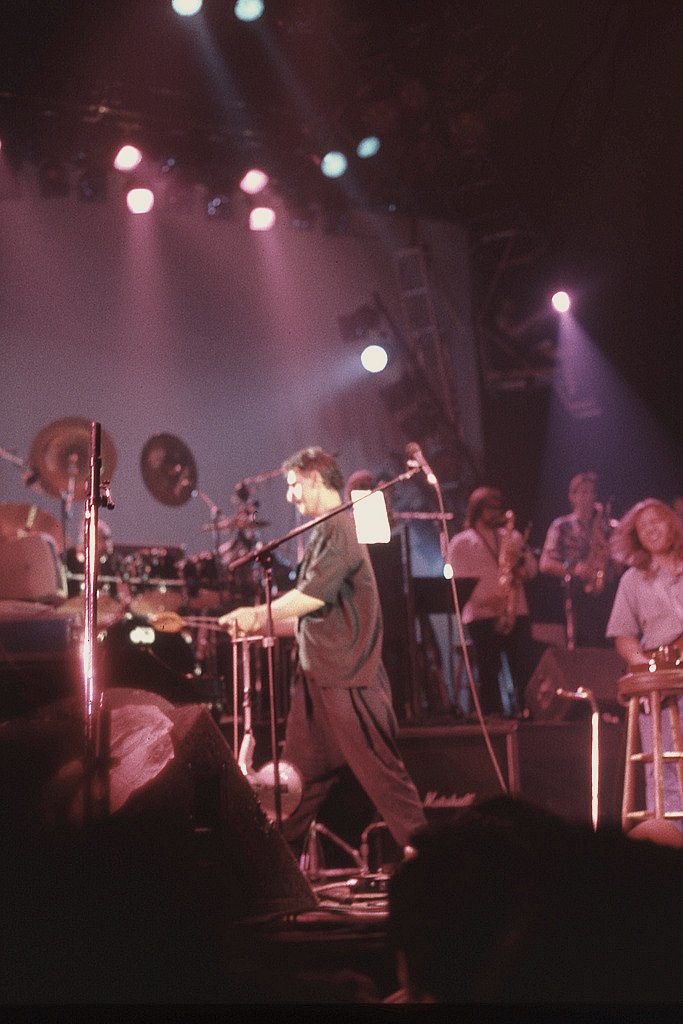 Next is a section of another country and western song, "Rhymin' man" from "Broadway the hard way". This comic song is all about the use of clichés. Its first theme is a typical country and western tune. The second theme
is a melody beginning with a motif comparable to the opening of "Lonesome cowboy Burt".
Every two bars the melody gets interrupted by two bars, that each time contain another familiar
sounding tune remindful of the showbusiness world. The song includes three of such blocks.
Next is a section of another country and western song, "Rhymin' man" from "Broadway the hard way". This comic song is all about the use of clichés. Its first theme is a typical country and western tune. The second theme
is a melody beginning with a motif comparable to the opening of "Lonesome cowboy Burt".
Every two bars the melody gets interrupted by two bars, that each time contain another familiar
sounding tune remindful of the showbusiness world. The song includes three of such blocks.
Rhymin' man, section (midi file).
Rhymin' man, section (transcription).
"Rhymin' man" is in A and
straightforward 4/4 for the lead melody. The interrupting bars can deviate from this by using altered notes
and moving through various forms of syncopic figures. Showbusiness is also the subject of "Any kind of pain" and maybe the reason for the title of the CD.
Rhymin' man, chorus (transcription).
The second example above is the chorus as transcribed by Christopher Smith. Christopher comments:
""Rhymin' Man," a savage critique of Jesse Jackson's political persona and style of discourse, is entirely constructed in order to facilitate
the sophisticated semiotic manipulation of Archetypal American musical icons. The strophic structure, arpeggiated guitar licks, root/fifth-oriented bass part,
and high tenor vocal harmonies are all defining characteristics of the cowboy-song genre. The idiom's antecedent-consequent phrase structure facilitates
insertion of rapid-fire melodic allusions, including melodramatic television themes for "The Twilight Zone" (line 6: "Oh you naughty Democrat!"),
"The Untouchables" (line 9: "Dipped his hands in the Doctor's blood"), and "Mission Impossible" (line 8: "Jesse hatched an awful plot"); stereotypical
bits of ethnicity including "Hava Nagilah" (line 18, quoting Jackson's "Over there near Hymie-Town") and "La Cucaracha" (line 21: "Castro was simpatico");
evocations of the circus ("March of the Gladiators" at line 17: "Farrakhan made him a clown"), the Presidency
("Hail to the Chief" at line 19: "Said he was a diplomat") and the Democratic Party ("Happy Days are Here Again" at lines
15-16: "A few years later, legend says/Rhymin' Man made a run for Prez"); and the editorial implications of sound
effects ("Teletype" motive at line 11: "Looked around for all the press"). All invoke associations, parody conventions, and comment
on textual events."
7. Promiscuous
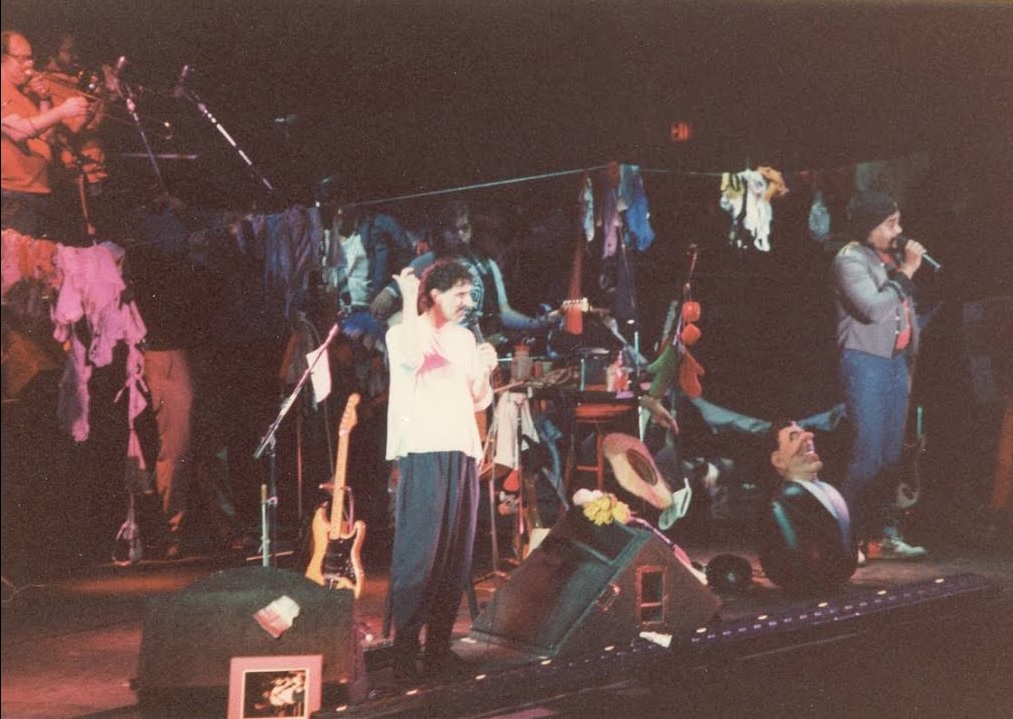 The last musical trend Zappa paid attention to was rap.
Because of its speech influence, rap
has some stylistic characteristics of its own. The singers are arguing as in a
sort of indictment, using only small intervals and keeping pace with a severe
steady beat. Zappa contributed with "Promiscuous" on "Broadway the
hard way", having Ike Willis arguing against the Aids speculations of Surgeon General Dr.
Koop.
The last musical trend Zappa paid attention to was rap.
Because of its speech influence, rap
has some stylistic characteristics of its own. The singers are arguing as in a
sort of indictment, using only small intervals and keeping pace with a severe
steady beat. Zappa contributed with "Promiscuous" on "Broadway the
hard way", having Ike Willis arguing against the Aids speculations of Surgeon General Dr.
Koop.
Promiscuous, opening (midi file).
Promiscuous, opening (transcription).
It's entirely following
the conventions of this style, but without a parody intent. The song is in D Mixolydian and begins
with hammering the I 7th chord for beat 1 of bars 1-4. This example has been in this study since 2005. I've renewed it in 2019
because the voicing of the 7th chord is different compared to how I notated it earlier: the bass plays a F#, guitar #1 a C and guitar #2 a D-chord on top of it.
The combination is D7, with the open tritone F#-C making this chord sound more dissonant than usual.
This renewal is a consequence of my discussion with Brett Clement. This exact tritone is the reason why he calls this chord prohibited
in his 2009 study and 2014 article: it would destabilize the overall Lydian tonic of his Lydian system (C in this case). See the Zoot allures section
for his way of reasoning. Next the singers enter into the picture with only a drum beat
to accompany them. At that point the song isn't really Mixolydian anymore.
Above to the right photos from the 1988 tour (downloaded from the internet, photographer unknown).
8. The untouchables
With "The untouchables" a series of covers of songs by others and new versions of Zappa's own songs begins. This title was written by Nelson Riddle as the theme for the TV series "The untouchables" from the sixties. Then it was an instrumental. Zappa wrote the lyrics for this version on his own CD, with Ike Willis being credited for doing the monologue.
9. Why don't you like me?
"Why don't you like me?" is for its music the "Tell me you love me" track from
"Chunga's revenge", with its lyrics adapted to Michael Jackson. See the corresponding section for the original 1970 version.
Why don't you like me?, 0:00-0:15 (midi file).
Why don't you like me?, 0:00-0:15 (transcription).
As about always Zappa revised the scores of existing songs when doing a new tour. Directly notable are the different rhythm of the first phrase of the main theme, as
well as the harmonization of the main theme. The 1970 version has no harmonization. Another version of this song comes from the 1980 tour, released on "Tinsel town rebellion".
On that occassion the original rhythm of the main theme remained intact, but also then a harmonization was added, different from the one used here.
Why don't you like me?, 1:12-1:33 (midi file).
Why don't you like me?, 1:12-1:33 (transcription).
At the time Jackson's album "Bad" got released the first signs of him trying to reshape his face got visible. Zappa couldn't have had an idea what happened afterwards.
Halfway the song begins with the band citing the main bass line from "Billy Jean", as well as the letting the brass section imitate the "Billy Jean is not my lover" phrase.
The bass line, at the bottom of bars 7-8 from the second example, is played much faster. It's directly recognizable as quoting "Billy Jean", but not identically.
Zappa continues with naming arbitrary people who aren't an alleged son of Michael Jackson, referring
to the line "the kid is not my son" from Michael Jackson's song.
10. Bacon fat
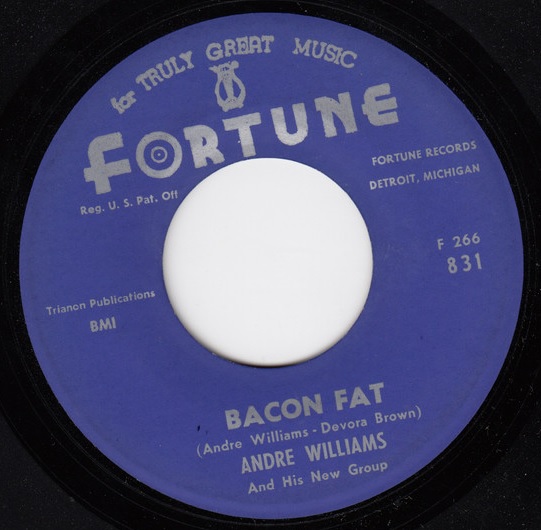 "Bacon fat" is a cover of a song by Andre Williams and Dorothy (Devora) Brown, recorded by Williams in 1956 (single to the right).
Zappa follows its music, but newly wrote the lyrics to turn it into a political song. The song with
its original lyrics can also be found as a cover on "Our man from Nirvana" from the "Beat the boots" series.
"Bacon fat" is a cover of a song by Andre Williams and Dorothy (Devora) Brown, recorded by Williams in 1956 (single to the right).
Zappa follows its music, but newly wrote the lyrics to turn it into a political song. The song with
its original lyrics can also be found as a cover on "Our man from Nirvana" from the "Beat the boots" series.
Start of the original 1956 lyrics:
While I was down in uh, Tennesee,
all my friends was glad to see me.
Seen some down by the railroad track,
seen some cotton pickers with their sacks on their backs.
They say hey man we're glad to see you back,
we got a new dance they call a Bacon Fat.
Start of Zappa's lyrics for "Broadway the hard way":
While I was down in W.D.C.,
certain folks were not glad to see me.
I just tried to get out the vote,
but some little weasel must 'a dropped 'em a note.
It said: "Check out the politics, practiced by this oaf.
And if they ain't just right, feed him confinement loaf."
11. Stolen moments
"Stolen moments" is an instrumental jazz classic, written by Oliver Nelson, on this occasion featuring Walt Fowler on trumpet. The 1988 tour saw the return of Bruce and Walt Fowler as members of the brass section. Together with their brother Tom, as bass player, they had contributed earlier to Zappa's albums from the seventies. "Stolen moments" was first recorded as "The stolen moment" for Eddie Davis' "Trane whistle" album, and got covered many times ever since.
12. Murder by numbers
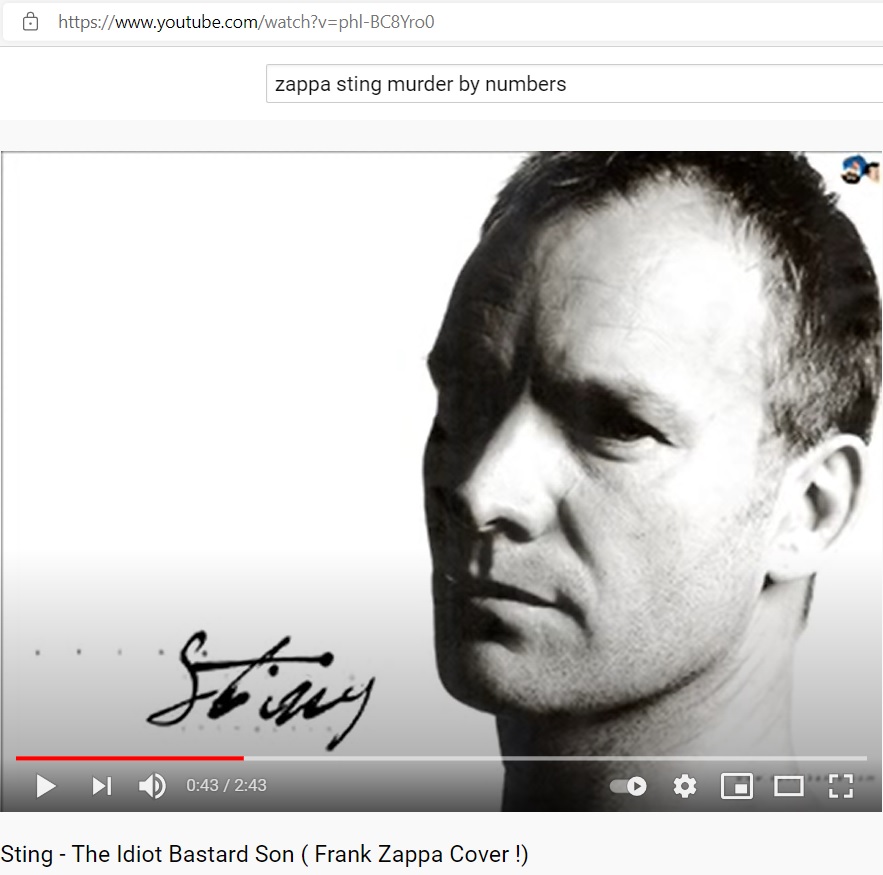 "Murder by numbers" is a song written by Sting, who has a guest appearance on this CD. The song was originally written for the "Synchronicity" album
by the Police. Zappa accidently met him in the hotel lobby
where he was staying, and asked him if he would like to perform with him. So the band had to learn this song
swiftly. It worked out well and Zappa thanked Sting, on stage of course, but also in the CD liner notes. Something similar happened with
Johnny Cash. The band had learned how to play "Ring of fire", but Johnny said he had to leave before the show because
his wife got sick. On this occasion the band played this song anyway with Zappa making some fun of the situation.
To the right Sting covering Zappa's song "The idiot bastard son" live, as you find it on YouTube (https://www.youtube.com/watch?v=phl-BC8Yro0).
"Murder by numbers" is a song written by Sting, who has a guest appearance on this CD. The song was originally written for the "Synchronicity" album
by the Police. Zappa accidently met him in the hotel lobby
where he was staying, and asked him if he would like to perform with him. So the band had to learn this song
swiftly. It worked out well and Zappa thanked Sting, on stage of course, but also in the CD liner notes. Something similar happened with
Johnny Cash. The band had learned how to play "Ring of fire", but Johnny said he had to leave before the show because
his wife got sick. On this occasion the band played this song anyway with Zappa making some fun of the situation.
To the right Sting covering Zappa's song "The idiot bastard son" live, as you find it on YouTube (https://www.youtube.com/watch?v=phl-BC8Yro0).
13. Jezebel boy
With "Jezebel boy" we're back at Zappa himself composing. Next is the opening of this song. It's to a degree diatonic, though not attributable
to keys. And there's a lot of chromaticism taking place. The song begins with a sustained Db chord on top of an E pedal, a dissonant combination.
Next the main theme gets presented. It follows a chromatically downwards moving chord progression: Db-C-B-Bb with an additional E by the bass
as passing note for each chord. Thus a sequence of major triads. Staves 2-3 in bars 3-10 represent sirens, mostly in dissonance with the
other parts, so creating an atmosphere of tension with police cars arriving. Rhythmic variation is achieved
by letting bar 3 continue in triplet time and the syncopic figure the bass is following.
Jezebel boy, 0:00-0:19 (midi file).
Jezebel boy, 0:00-0:19 (transcription).
"Jezebel boy" is a strange song, both regarding its structure and lyrics. It depicts a situation in the Hollywood Boulevard district in L.A.
with policemen rounding up female prostitutes with short pants, while at the same time a distinguished gentlemen in a Lincoln
is meeting a male prostitute, apparently unhindered, the Jezebel boy. Even more peculiar is what guitarist Mike Keneally writes as a comment upon this song in the
diary he kept, available on-line:

14. Outside now (1988)
Following below is the theme from the specific "Broadway the hard way" version
of "Outside now", thus including the additional harmonies by the brass section from the 1988 tour. Joe is wailing "I can't wait to see what it's like
on the outside now", sung over a vamp that is getting used all through this song, also for the guitar solo in it.
The Joe's garage section contains the opening of "Outside now, 1979 version" with the introduction of the vamp.
Outside now (1988), theme (midi file).
Outside now (1988), theme (transcription).
"Outside now" is in Bb Lydian, determined by the bass movement in staff 3. It alternates bars with Bb and C in two different
meters (6/8 and 5/8). Otherwise the rhythm is even: a straight string of eight notes.
The vamp from staves 2-3 is moving freely through the scale, avoiding any attempt to form
a traditional 5th or 7th chord: the first seven notes are all the notes from the scale played once. The interval jumps
between the notes keep varying. The sung staff 1 on the other hand does to some extent follow the Am chord. The brass in bar
4 is specific for the 1988 execution.
15. Hot plate heaven at the Green hotel
The theme from the 1984 version of "Hot plate heaven at the Green hotel" is included in the Does humor belong in music? section of this study. This song in its entirety is thus twice present in Zappa's output, while two more solos taken from other performances can be found on "Trance-fusion". Their relationships are also discussed in this study.
16. What kind of girl?
"What kind of girl?" belongs to the so-called
groupie opera from the 1970-71 tours. These form a specific intertwined story, so the individual songs from this opera weren't fit for inclusion
in other tours. See the Fillmore East section for an example from the 1971 version
of "What kind of girl do you think we are?".
In 1988 TV evangelist Jimmy Swaggart got caught visiting a prostitute. By itself nothing illegal about it, but
in his condition the hypocrisy of it was severely embarrassing. Zappa simply loved this coming out to the open and couldn't
resist adapting the lyrics of some of his songs to the occasion, like in "What kind of girl?".
What kind of girl?, 0:00-0:32 (midi file).
What kind of girl?, 0:00-0:32 (transcription).
The general set-up of this piece goes as:
- 0:00 Compared to the original from 1971, this instrumental intro is new. It follows old-fashioned striptease music standards
and, for that reason, fits in well into the context of this section. You've got the band members largely improvising over
the bass progression that ends the central theme of the song. It goes upwards as A-C#-D-D#-E. First with two beats per note during
bars 1-2, next with a note per beat in bar 3.
Nominally this song is in A Mixolydian, but the C turns up just as much as natural as as sharp. Bars are switching between A Mixolydian
and A Dorian. The intro, like the phrase it's derived from, ends with playing around a chord progression. Here it's a F-E progression,
thus further challenging the A Mixolydian tonality. Altered notes as D# and B# are used as well.
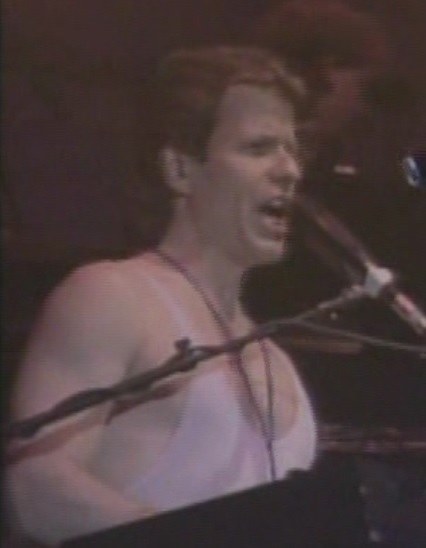 - 0:16 Central theme, following the blues scheme. During bars 5-7 you've got the four vocalists singing in lower registers. In bars 8-9 Bobby Martin
(image to the right) is continuing
solo in a high register, kind of suggesting the higher voice of a prostitute compared to her male visitors. The basic rhythm of this piece is three ticks per beat, thus
embedded in a 12/8 meter. Frequently beats get subdivided into two as well. Bobby Martin is here singing in an irregular rubato manner. These bars 5-9 are
steps I-IV from the blues scheme. The example from above stops here and the song continues with IV-I-V-IV-I. At 0:48 the bass line, that got
mentioned above, is used for ending the theme. This time it's followed by a C-Bm chord progression.
- 0:16 Central theme, following the blues scheme. During bars 5-7 you've got the four vocalists singing in lower registers. In bars 8-9 Bobby Martin
(image to the right) is continuing
solo in a high register, kind of suggesting the higher voice of a prostitute compared to her male visitors. The basic rhythm of this piece is three ticks per beat, thus
embedded in a 12/8 meter. Frequently beats get subdivided into two as well. Bobby Martin is here singing in an irregular rubato manner. These bars 5-9 are
steps I-IV from the blues scheme. The example from above stops here and the song continues with IV-I-V-IV-I. At 0:48 the bass line, that got
mentioned above, is used for ending the theme. This time it's followed by a C-Bm chord progression.
- 0:54 Central theme some more. Variations and additions turn up during the repetitions of the theme all through this song.
- 1:43 Citation from "Strawberry fields forever" by The Beatles. Zappa covered a number of classic tunes and pop-songs during his 1988
tour, including Beatles songs. No Beatles songs appeared on CD due to copyright related reasons. "Lucy in the sky with diamonds" got
played too, with the opening line adapted to the Swaggart situation as "picture yourself on a whore in a motel".
- 2:00 Central theme for the third time.
- 2:38 Central theme, now with the title from the song as part of the lyrics.
17. Jesus thinks you're a jerk
The closing song of "Broadway the hard way", called "Jesus thinks you're a jerk", opens with an outspoken cliché theme.
It sounds as a joke, as if a vaudeville show might begin. The entire song is a sequence of four blocks. The connection
between the blocks is made by some cross references and, of course, the lyrics.
Block I:
During the first block the opening theme
is repeated several times. Zappa keeps it interesting by adding extra phrases to this theme and varying it via different
settings. The notes of the basic melody remain unaltered. The first example below is in C and one of these instances
with the main theme being played. At 3:16 a second theme turns up before the main theme gets played one more time.
- 0:00 Theme A, instrumentally, lasting 13 seconds.
- 0:14 Pick up notes ("There's an ...").
- 0:17 Theme A, sung. Zappa inserts two little add-ins at 0:26-0:32 and 0:34-0:37.
Combined these 10 seconds explain, why this
instance of theme A, being sung, lasts 23 seconds in total. The tempo has remained the same.
- 0:40 Theme A, instrumentally, with a different instrumentation.
- 0:53 Theme A, sung.
- 1:07 Theme A, instrumentally, similar to 0:40. At this point the first example below starts.
Jesus thinks you're a jerk #1, 1:08-1:22 (midi file).
Jesus thinks you're a jerk #1, 1:08-1:22 (transcription).
- 1:20 Theme A, sung.
- 1:32 Variation upon theme A.
- 1:43 Theme A, instrumentally. The accompaniment and bass are now playing at double speed while the lead melody remains the
same.
- 1:56 Theme A, sung, a little cut off at the end.
- 2:07 A longer add-in becomes a side theme ("To the bank..."), in some of its aspects related to theme A.
- 2:25 Theme A, instrumentally, with several of the repeating notes skipped. It thus sounds as slowing down, while at
1:43 it sounded as an acceleration. The same number of bars is still played during 13 seconds as at the beginning.
- 2:38 Theme A, sung, a little faster.
- 2:49 A repeated second side theme, also still being related to theme A. A couple of times the sung bars alternate
with instrumental bars.
- 3:16 Theme B, sung ("Convinced they are..."). This is truly a new theme, played over an alternation of Em7 and Dm7. It's sung four times, the last time with some rhythmic variation in it.
- 4:02 Theme A, sung, no brass or keyboards this time.
- 4:12 The second side theme from 2:49 returns twice. Bars 1-6 from the second example below contain its tail with Zappa
preparing the transition to Block II ("And now, ladies and gentlemen, ...").
Jesus thinks you're a jerk #2, 4:19-4:35 (midi file).
Jesus thinks you're a jerk #2, 4:19-4:35 (transcription).
Block II:
- 4:28 After Zappa has introduced Eric Buxton, this
second block continues with Eric doing a little speech in a gloomy atmosphere. This surrounding is created via
dissonants, a chromatic bass line and a diminished 5th chord in the background (if I hear it right). It follows a pattern
lasting four bars with the bass lick of one bar returning every four bars and pausing in the other three. One might call this
theme C. The midi file
sounds a bit crappy here; it's hard to represent someone talking in midi format. Bars 7-12 from the second example
are the opening of this block with Eric taking over from Zappa from bar 9 onwards.
Block III:
- 5:48 Theme D. When Eric has finished
his speech,
a more regular pop block follows. It begins with the main theme of this block, played
over an alternation of Em7 and Fmaj7, the bass switching between C and F underneath it. In this block III this
Em7 and Fmaj7 chord alternation, later on Am/Am7 and G, is more a constant factor than the pedal notes, that keep changing
position.
- 6:11 Variations upon theme D.
- 6:30 Reference to block II.
- 6:33 Theme D returns as presented below, again with a reference to block II.
This time the original Fmaj7 chord gets played before the Em7 chord and
both chords get reduced. Without the F and E as root they become Am and G. Material from the second block returns in the
interrupting bars 11-12 and 15-16.
Jesus thinks you're a jerk #3, 6:33-7:01 (midi file).
Jesus thinks you're a jerk #3, 6:33-7:01 (transcription).
- 6:55 Theme D once more, now with Am7 and G alternating and the bass switching between F and D as pedal notes.
- 7:07 Side theme ("Then surely...").
- 7:31 Variation upon theme D with the original Em7 and Fmaj7 alternation as at the beginning. At the end of the second repetition you shortly get to hear one of the many vaudeville
like instrumental passages.
- 7:42 The side theme from 7:07 returns, followed by a coda for this block.
Block IV:
- 8:04 Theme E. At 8:04 a fourth block starts, again with a vaudeville like theme ("there's an old
rugged cross"). This part thus refers to the opening as it comes to style.
- 8:15 As a closing for theme E, one of the various quotes of the "Louie
Louie" progression can be heard, also mentioned in the Absolutely free section. Zappa liked to include this progression
every once in a while in his compositions.
- 8:32 Coda.
- 8:56 Intermission of the show starts.
- 9:17 End.
